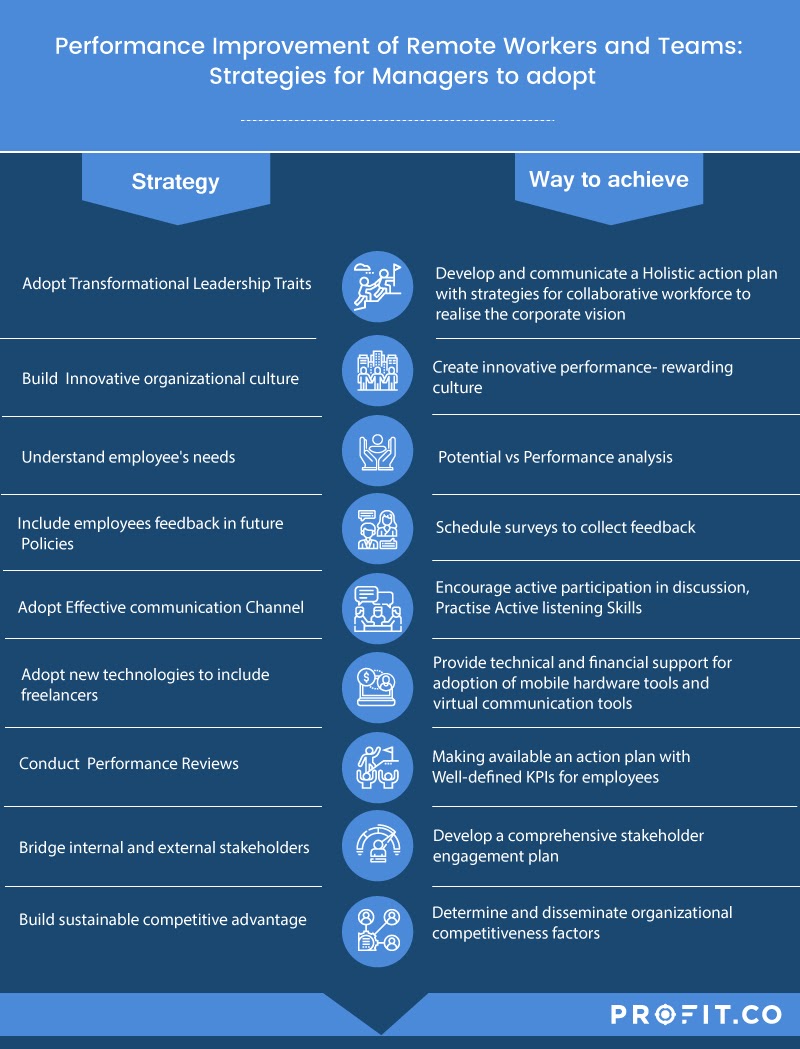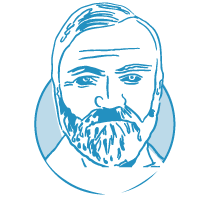Global shift to WFH
After the onset of the COVID-19 pandemic, companies around the world experienced a paradigm shift in the way they operated. Many companies have shifted to a remote work environment and now require the adoption of new management practices and policies. These new trends in workplace environments require managers to come up with effective strategies that will help them gain maximum benefit from the remote working teams.
Every challenge is an opportunity in disguise. For example, we have seen that the increased climate challenges in the 21st century have encouraged organizations to invest in eco-friendly initiatives. The current pandemic challenge will force companies to focus more on the remote work environment.
Teamwork is the ability to work together towards a common vision, the ability to direct individual accomplishments toward organizational objectives. It is the fuel that allows common people to attain uncommon results.
A survey from Buffer conducted in 2019 stated that 99% of workers want to be in a remote work environment at least for a brief period in their careers. This is now a reality. Tech giants like Apple, Microsoft, and Google have adopted new remote work cultures and this trend is expected to last long. CNBC reported that Sunder Pichai, CEO of Google and Alphabet, has said, “We were one of the first companies to move to WFH; we will be equally careful about our transition back to the office.”
Another analysis by FlexJobs in 2019 stated that remote work has risen by 44% and 91% in the last five and ten years respectively. And the manager’s role of supervising remote workers’ performance improvements has only become more important.
Top-level managers find it challenging to achieve high productivity from remote workers because of the lack of face-to-face interaction and management. It is a well-known fact that management style adjustments to new trends require proper research, resource allocation, and effective planning to ensure improvement in employees’ performance.
A study conducted by Enterprise Strategy Group (ESG), a leading technology analyst, research, and strategy firm, shows high productivity levels among remote workers, and that 57% prefer to increase their remote work in the future.
One thing is crystal clear; a large percentage of permanent employees will continue to work remotely in the future. Many managers are trying innovative management strategies to help improve employee performance and achieve high productivity levels. Below, you’ll find some strategies that you can use to further improve your team’s performance during remote work.
9 Strategies for Managers to adopt for performance improvement of remote workers and teams
When you’re surrounded by people who share a passionate commitment around a common purpose, anything is possible.
Here are a few recommendations from a recent Deloitte report on the establishment of a remote work environment:
- Team leaders should review the team members responsibilities
- Consistent communication should become compulsory
- Use virtual technology tools to achieve high collaboration
- Relevant risk areas should be identified, such as securing the confidential data and development of security policies
- Team leaders should properly monitor the wellbeing and project satisfaction of remote workers
-
Adoption of Transformational Leadership Style
-
Innovative Organizational Culture
-
Maslow’s Hierarchy of Needs and Employees Motivation
-
Scheduled Surveys to Collect Feedback
-
Communication Strategies for Remote Workers
-
Understanding New Technologies to Manage Remote Work
-
Conducting Performance Evaluation and Reviews
-
Involvement of Stakeholders
-
Sustainable Competitive Advantage
Managers should become role models for colleagues. Every manager has to invest in developing an innovative culture, deploying the right technologies, and introducing suitable performance metrics. Transformational leadership style is one suitable way for managers to encourage and motivate employees.
Transformational leaders are charismatic and effective communicators who are open to new ideas. In a remote working environment, the transformational leader will be able to devise an effective way to ensure employees’ involvement, develop a collective vision, encourage a culture of innovation, and be able to communicate well with every stakeholder to overcome any resistance to change.
Transformational leadership traits help in the team-building process and increase positive attitudes at the workplace. There is better work delegation and the decision-making process improves, resulting in higher growth.
Managers can also use technologies like data analytics and artificial intelligence (AI) for supervising employees. Data analytics enables the managers to identify significant insights from stored employee’s data to introduce new changes. Organizations can collectively use data analytics and AI to achieve exceptional employee performance.
In every organization, the millennials form a large part of the workforce. A study from Freshminds reveals that millennials prefer transformational leaders because of the increase in engagement and inspiration. When practices encourage the involvement of every internal stakeholder in organizational activities, a more innovative culture is promoted.
Verbal and non-verbal communication with employees is a must to ensure high performance in a remote work environment. Frequent communication can help establish personal and professional objectives and growth plans. The question is, why is it essential to define personal objectives? Buffer’s survey report shows that while working remotely 22%, of workers find it challenging to unplug from work, 19% consider loneliness their greatest challenge, and 17% think collaboration and coordination is more difficult. Therefore, defining personal objectives helps bring clarity to what employees should focus on and how to achieve them most effectively.
Rewarding an employee’s contributions with monetary and non-monetary incentives reflects a performance rewarding culture. New HR parameters need to be identified that improve work culture, decrease turnover rate, and achieve organizational objectives set.
When it comes to employee motivation, it is important to understand Maslow’s five-stage model of the hierarchy of needs. Fulfillment of employee’s needs is vital in improving their performance and productivity, especially in a remote environment.
Managers should recognize the potential of remote workers and provide growth opportunities at work. To help employees reach the final level in Maslow’s Hierarchy of Needs, self-actualization, managers should attempt to maximize an employee’s potential at work through increased employee engagement. To feel motivated and give their best in a job, employees should feel that they are appreciated and important.
Conducting surveys to improve employee performance is very beneficial if you want to collect employees’ feedback about current policies and take suggestions for future improvements. Organizations have the responsibility to integrate the most useful suggestions for future policies. A survey conducted by the survey-creator site SurveyMonkey indicates that only 40% of workers feel that organizations pay attention to their responses in feedback surveys. Therefore, as a manager you should do all you can to assure employees that their feedback is valued, and will be considered when creating or altering policies within the company. Quarterly or annual surveys are also important to increase the engagement of remote workers.
Many softwares have a survey feature you can use to communicate with your team. For example, Profit.co has an extensive feedback mechanism feature called Pulse Surveys that can help you keep your team engaged. You can get started on Profit.co for free today!
Effective communication with co-workers is the single most crucial ingredient for high productivity. Remote workers in FYI’s remote work report identify communication, social opportunities, and loneliness as the top three challenges.
To remedy employees’ feelings of loneliness and miscommunication, teams have many options for collaboration. Common communication mediums include chat, video conferences, email, and meetups. Employees will become more communicative as managers develop a collaborative culture and address the challenges, needs, and expectations of workers.
Managers should engage workers and teams by encouraging them to participate actively in discussions and give honest feedback about organizational policies. Detail-oriented and active listening skills can resolve any conflict or dispute among employees.
Technology transforms the workplace environment to make it productive. Freelancing is on the rise, and a recent survey conducted by Finances Online estimates that the number of freelancers has reached 64.6 million, and will increase to 90.1 million by 2028.
Now that it has become clear that remote work is here to stay, managers will have to select relevant technologies to cater to the needs of freelancers and permanent employees working in a remote environment. Some of the popular communication tools are Zoom, Slack, and FormStack.
To work efficiently, remote workers require different kinds of tools, including mobile hardware, virtual communication, project management, and employee engagement tools. Managers are usually responsible for identifying relevant technical and technological requirements. The organization should arrange appropriate financial resources to deploy the right technologies suitable for the fulfillment of tasks and responsibilities.
The famous management guru Peter Drucker has stated: “you can’t manage what you can’t measure.” Managers’ performance evaluation methods play a critical role in managing the performance of employees. Performance reviews need to be based on measurable goals set at the start of a project.
Performance reviews based on clearly defined systems, KPIs and objectives enable a manager to identify areas of improvement in employees’ performance, practices and policies. Managers can develop an action plan in a situation where remote workers are unsuccessful in meeting the KPI’s. Management excellence depends on strategies, initiatives, and positive changes introduced in the post-performance review period. Performance review templates can come in handy to plan and conduct an employee performance review quickly and effectively. For an employee evaluation to get the right results, it has to be inclusive, fair and objective.
Organizational policies should increase the interest and engagement of stakeholders.
Performance management and measurement should involve stakeholders’ suggestions. Managers have the responsibility to communicate with internal stakeholders like employees and founders and external stakeholders like customers, investors, suppliers, and creditors to get a full perspective on what skills an employee must be evaluated on, and the scope of their responsibilities.
Managerial skills are essential for developing a comprehensive stakeholder engagement plan. The manager works as a bridge between the external and internal stakeholders to ensure that organizational objectives are achieved, and employees understand each facet of their role.
Howard Schultz, the former CEO of Starbucks, has used specific strategies for the achievement of sustainable competitive advantage. These strategies are an excellent source of knowledge for every manager. Howard’s journey reflects how innovation in a workplace environment can help to develop a multi-billion-dollar brand. A manager’s innovative and creative skills can help to determine new strategies suitable for a specific requirement of the remote work environment.
An employee’s capability to achieve defined objectives depends on their manager’s ability to utilize the maximum potential of human resources. Managers should have the right skills and professional experience to determine organizational competitiveness factors to develop a strategic direction for remote workers. Valuable information about strategic direction and objectives should be shared with employees to monitor and evaluate employees’ efforts for the achievement of competitive advantage.
Market conditions in developed and emerging markets have changed. Improvements in employee’s performance are vital for organizations to compete and grow in the current business environment. Employee’s behavior, engagement, and productivity depend on the effectiveness of organizational policies and procedures.
Lack of managerial skills can create challenges in terms of controlling, monitoring and organizing the activities of remote workers. Organizations are responsible for developing suitable training programs to increase the skills and professional experience of managers to supervise remote workers. The return on investment for training can be high and be seen in the form of new skills in managers and increased productivity of remote workers.
Employee performance improvement and increased engagement helps develop strong brand equity so that a business can compete in any market conditions.

How can Profit.co Software help Performance Improvement?
Profit.co software offers a variety of features that can make remote working easier more productive, and help employee performance throughout the quarter.
In the Performance Management Software, Profit.co offers employee reviews that encourage a dialogue between managers and employees. These reviews can be conducted quarterly or annually, and offer the opportunity for employees to assess their own progress and performance, as well as receive feedback from peers and managers.
Additionally, the OKR methodology lends itself well to remote work. Business leaders and managers have complete visibility concerning the progress of OKRs within departments, and that transparency enables them to see where things are running smoothly, and where help is needed to get back on track.
Weekly check-ins on key results ask that employees reflect on their progress and are reminded of their goals for the quarter, aligning their day-to-day tasks– even ones done in their home– with quarterly Objectives.
To learn more about how Profit.co’s OKR management platform can transform the way your company works remotely, schedule a free demo with our experts!


